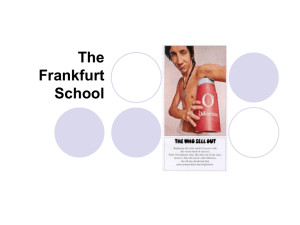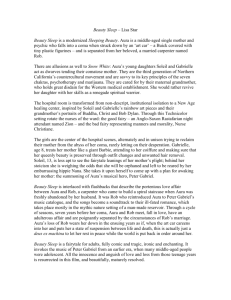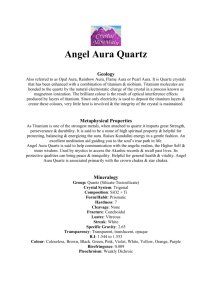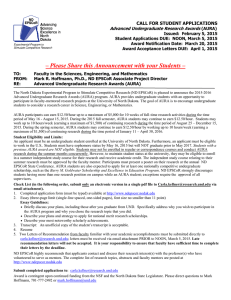AURA: Enabling Subject Matter Experts to Construct Declarative
advertisement
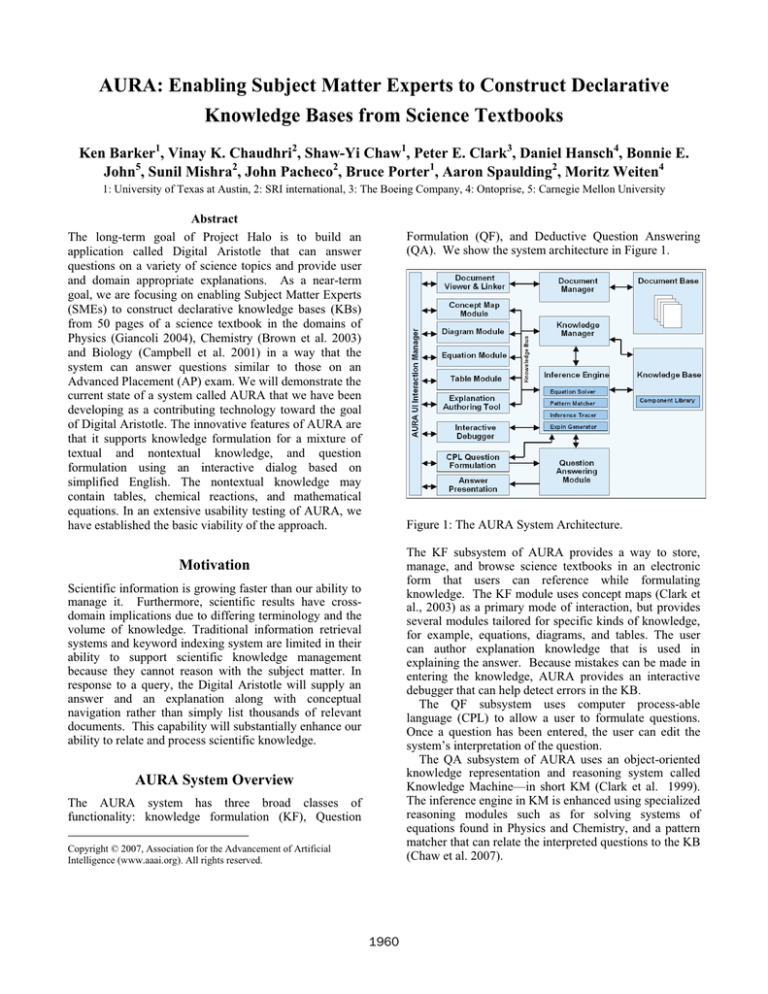
AURA: Enabling Subject Matter Experts to Construct Declarative Knowledge Bases from Science Textbooks Ken Barker1, Vinay K. Chaudhri2, Shaw-Yi Chaw1, Peter E. Clark3, Daniel Hansch4, Bonnie E. John5, Sunil Mishra2, John Pacheco2, Bruce Porter1, Aaron Spaulding2, Moritz Weiten4 1: University of Texas at Austin, 2: SRI international, 3: The Boeing Company, 4: Ontoprise, 5: Carnegie Mellon University Abstract The long-term goal of Project Halo is to build an application called Digital Aristotle that can answer questions on a variety of science topics and provide user and domain appropriate explanations. As a near-term goal, we are focusing on enabling Subject Matter Experts (SMEs) to construct declarative knowledge bases (KBs) from 50 pages of a science textbook in the domains of Physics (Giancoli 2004), Chemistry (Brown et al. 2003) and Biology (Campbell et al. 2001) in a way that the system can answer questions similar to those on an Advanced Placement (AP) exam. We will demonstrate the current state of a system called AURA that we have been developing as a contributing technology toward the goal of Digital Aristotle. The innovative features of AURA are that it supports knowledge formulation for a mixture of textual and nontextual knowledge, and question formulation using an interactive dialog based on simplified English. The nontextual knowledge may contain tables, chemical reactions, and mathematical equations. In an extensive usability testing of AURA, we have established the basic viability of the approach. Formulation (QF), and Deductive Question Answering (QA). We show the system architecture in Figure 1. Figure 1: The AURA System Architecture. The KF subsystem of AURA provides a way to store, manage, and browse science textbooks in an electronic form that users can reference while formulating knowledge. The KF module uses concept maps (Clark et al., 2003) as a primary mode of interaction, but provides several modules tailored for specific kinds of knowledge, for example, equations, diagrams, and tables. The user can author explanation knowledge that is used in explaining the answer. Because mistakes can be made in entering the knowledge, AURA provides an interactive debugger that can help detect errors in the KB. The QF subsystem uses computer process-able language (CPL) to allow a user to formulate questions. Once a question has been entered, the user can edit the system’s interpretation of the question. The QA subsystem of AURA uses an object-oriented knowledge representation and reasoning system called Knowledge Machine—in short KM (Clark et al. 1999). The inference engine in KM is enhanced using specialized reasoning modules such as for solving systems of equations found in Physics and Chemistry, and a pattern matcher that can relate the interpreted questions to the KB (Chaw et al. 2007). Motivation Scientific information is growing faster than our ability to manage it. Furthermore, scientific results have crossdomain implications due to differing terminology and the volume of knowledge. Traditional information retrieval systems and keyword indexing system are limited in their ability to support scientific knowledge management because they cannot reason with the subject matter. In response to a query, the Digital Aristotle will supply an answer and an explanation along with conceptual navigation rather than simply list thousands of relevant documents. This capability will substantially enhance our ability to relate and process scientific knowledge. AURA System Overview The AURA system has three broad classes of functionality: knowledge formulation (KF), Question Copyright © 2007, Association for the Advancement of Artificial Intelligence (www.aaai.org). All rights reserved. 1960 improve AURA’s ability to correctly answer questions we are working in three areas: (1) With knowledge revision, we will ensure that whenever update in one part of the KB affects other parts, it is propagated correctly; (2) With knowledge testing, we will provide facilities to KFEs to adequately test the encoded knowledge so that it can handle questions by the QFEs; (3) With an expanded expressiveness of the KF interface, we will increase the range of questions answered to the point that the system can get a perfect score on the three APs. Outside the context of the evaluation so far, we are undertaking a major architectural enhancement to enable authoring of simpler forms of knowledge by much less training than forty hours, and to leverage a larger population of contributors over the web. Our approach for doing this, illustrated in Figure 2, is to interface the AURA system with a Semantic Media Wiki. Current Target Users of AURA We designed The AURA system for two types of SMEs: Knowledge Formulation SMEs (KFEs), who are graduate students in sciences, and Question Formulation SMEs (QFEs), who are undergraduate students. The KFEs undergo 40 hours of training and the QFEs undergo 4 hours of training. We assumed KFEs to have a greater degree of training in their field as KF requires greater sophistication. We assumed QFEs to have limited training because the system is likely to have many such users and we wanted the bar of entry to be low. We chose the current training and experience requirements based on what we considered achievable for a near-term evaluation. It is not the ultimate goal of AURA to require 40 hours of training before use. Semantic Wiki Evaluation We conducted extensive usability testing of AURA during June 2006. We used six KFEs who received 40 hours of training and then used AURA for a period of approximately 20 days each to encode knowledge about Physics, Chemistry, and Biology. A separate set of six QFEs received 4 hours of training on the question answering component, and then spent one week posing AP-like questions to AURA. We assessed the AURA system by three metrics: (1) time to formulate knowledge, (2) SME need for help, and (3) KB correctness. The average time for users to formulate a page of text was approximately 1.3 hours. In total, six users with 40 hours of training authored 160 pages of textbook science knowledge in one month using AURA We provided the users with instant messenger (IM) to request help, and we recorded all the IM sessions. In total, there were 67 requests over 480 hours of total AURA use time, which translates to one request for help every 8 hours. There were no help requests made by the QFEs. While all KFEs required help at least once, they were able to work for long periods without requiring help, which suggests that the design and training combined to produce a reasonably usable system. The QFEs posed 363 questions. The correctness scores for these questions ranged from the lowest score of 21% for a Physics KB, 42% for a Chemistry KB, to 51% on a Biology KB. For KBs to be created by science graduate students (not knowledge engineers), and the questions to be asked by different science students (with no knowledge of the underlying knowledge base), to approach this level of performance is an impressive achievement of usercentered design in this difficult arena. AURA map ontology (OWL/RDF) ontology (OWL/RDF) mappings +models deploy Semantic Wiki Knowledge Services import AURA Figure 2: Interfacing AURA to a Semantic Media Wiki The primary challenge in implementing this architectural extension is to semantically map and deploy the socially authored knowledge in a Media Wiki into the AURA KB. References Giancoli, D. C., Physics Principles with Applications. Benjamin Cummings, 2001. Brown, T. L. et al., Chemistry: The Central Science. Prentice Hall, 2003. Campbell, N.A. et al., Biology, Sixth Edition. Benjamin Cummings, 2001. Clark, P. et al., Knowledge Entry as the Graphical Assembly of Components, KCAP, 2003. Clark, P. et al., KM Users Guide, 1999. Chaw, J. et al., A Knowledge-Based Approach to Answering Novel Physics Questions. (Submitted 2007) Völkel, M. et al., Semantic Wikipedia. ISWC’06. Future Work Acknowledgement The evaluation showed that the SMEs could formalize knowledge to successfully answer some questions. To This work was funded by Vulcan Inc. 1961
